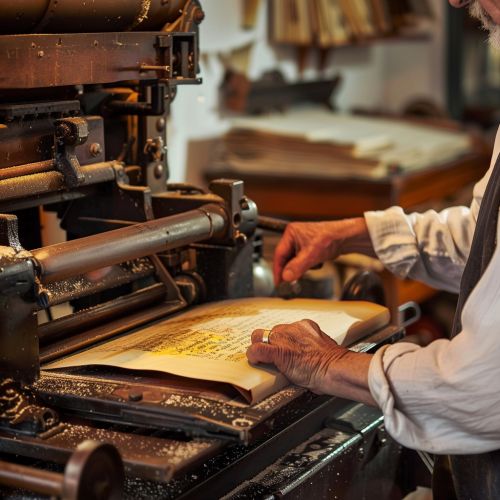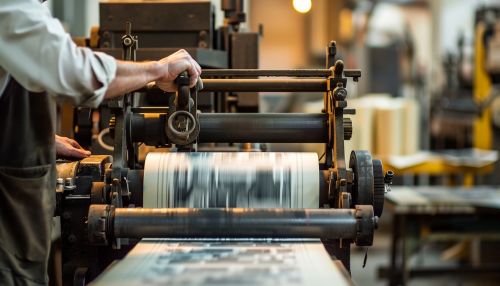Print Media
Introduction
Print media refers to the industry associated with the printing and distribution of news and information through physical publications. This encompasses newspapers, magazines, books, and other printed materials. Print media has played a crucial role in the dissemination of information, education, and entertainment throughout history. Despite the rise of digital media, print media continues to hold significant importance in various sectors.
Historical Development
Early Beginnings
The origins of print media can be traced back to ancient civilizations where various forms of written communication were used. The invention of paper by the Chinese during the Han Dynasty (206 BCE – 220 CE) was a pivotal development. However, it was the invention of the printing press by Johannes Gutenberg in the mid-15th century that revolutionized the production of printed materials. Gutenberg's movable type printing press enabled mass production of books and other documents, making information more accessible to the general public.
The Renaissance and Enlightenment
During the Renaissance, the proliferation of printed books facilitated the spread of knowledge and ideas, contributing to significant cultural and intellectual advancements. The Enlightenment period saw further expansion of print media, with newspapers and pamphlets becoming essential tools for political and social discourse. The ability to disseminate information quickly and widely played a key role in shaping public opinion and fostering democratic ideals.
Industrial Revolution
The Industrial Revolution brought about significant technological advancements that further transformed print media. The development of steam-powered printing presses and the introduction of mechanized typesetting increased the efficiency and speed of printing. This period also saw the rise of mass-circulation newspapers and magazines, which became influential in shaping public opinion and culture.


Types of Print Media
Newspapers
Newspapers are periodical publications that provide news, information, and commentary on current events. They are typically published daily or weekly and cover a wide range of topics, including politics, business, sports, and entertainment. Newspapers have traditionally been a primary source of news for the public, although their influence has waned with the advent of digital media.
Magazines
Magazines are periodical publications that focus on specific subjects or interests. They are usually published weekly, monthly, or quarterly and often contain articles, interviews, and photographs. Magazines can be categorized into various types, including consumer magazines, trade magazines, and academic journals. Each type serves a distinct audience and purpose.
Books
Books are long-form printed works that cover a wide range of genres and subjects. They can be fiction or non-fiction and are typically bound and published in multiple copies. Books have been a fundamental medium for preserving and disseminating knowledge, literature, and culture throughout history.
Pamphlets and Brochures
Pamphlets and brochures are short printed materials used for informational or promotional purposes. They are often distributed for free and are commonly used by organizations, businesses, and governments to convey specific messages or advertise products and services.
Impact of Print Media
Social and Cultural Influence
Print media has had a profound impact on society and culture. It has been instrumental in shaping public opinion, influencing political decisions, and promoting social change. The widespread availability of printed materials has also contributed to increased literacy rates and the democratization of knowledge.
Educational Role
Print media has played a crucial role in education by providing textbooks, reference materials, and scholarly journals. These resources have been essential for academic research and learning, enabling students and educators to access a wealth of information.
Economic Impact
The print media industry has significant economic implications, providing employment to millions of people worldwide. It encompasses various sectors, including publishing, printing, distribution, and retail. Despite challenges posed by digital media, print media continues to generate substantial revenue.
Challenges and Adaptations
Decline in Circulation
The rise of digital media has led to a decline in the circulation of print media. Many newspapers and magazines have experienced reduced readership and advertising revenue, prompting some to cease publication or transition to digital formats.
Environmental Concerns
The production and disposal of printed materials have raised environmental concerns. The print media industry has faced criticism for its impact on deforestation, energy consumption, and waste generation. In response, many publishers have adopted sustainable practices, such as using recycled paper and eco-friendly inks.
Digital Integration
To remain relevant in the digital age, many print media organizations have integrated digital platforms into their operations. This includes the development of online editions, mobile apps, and social media presence. These digital initiatives aim to reach a broader audience and provide interactive and multimedia content.
Future of Print Media
Niche Markets
While mass-circulation print media faces challenges, niche markets have shown resilience. Specialized publications that cater to specific interests or professional fields continue to thrive. These niche markets often have dedicated readerships and can command higher advertising rates.
Print-on-Demand
Print-on-demand technology allows for the production of printed materials as needed, reducing waste and inventory costs. This technology has enabled self-publishing and small-scale publishing, providing opportunities for independent authors and publishers.
Hybrid Models
Many print media organizations are adopting hybrid models that combine print and digital offerings. These models aim to leverage the strengths of both formats, providing readers with the tactile experience of print and the convenience of digital access.
Conclusion
Print media has a rich history and has played a vital role in the dissemination of information and culture. Despite facing significant challenges in the digital age, it continues to adapt and evolve. The future of print media lies in its ability to innovate and find new ways to engage readers while maintaining its traditional strengths.
